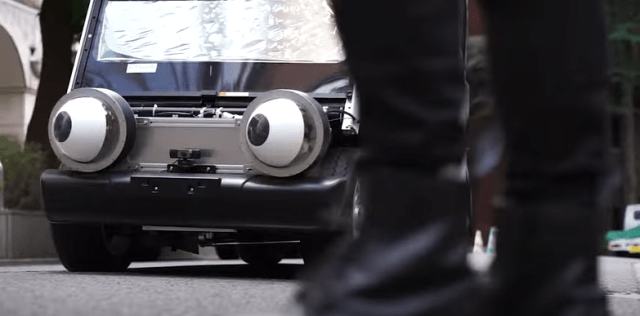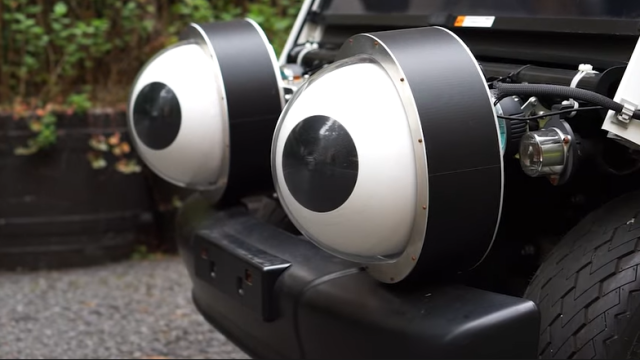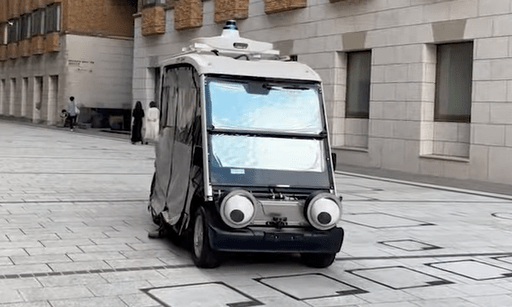
The cars have eyes.
In urban areas, crosswalks are always a roll of the dice. These zebra-striped paths are intended for pedestrians to cross freely without fear of getting struck by a car, and for the cars themselves to know they should stop upon seeing a person using them.
That’s how it all works in theory, but as anyone who lives in a city will tell you, drivers don’t always heed this rule. Before I never crossed when a car was near because I never really trusted that the driver was alert enough to see me. On the other hand, after getting a license of my own I softened on the issue because now I realize that not crossing the street kind of screws with the driver’s head too.
This failure to communicate is quite a dilemma, and it sure would be nice if there was a visual reference that would let pedestrians know that a driver sees them and validates them as a person that shouldn’t be struck with their heavy machinery.
But maybe there is…
Although it rather looks like it, this video is not a joke. It’s “Gazing Car,” the concept of Chia-ming Chang, a lecturer at the University of Tokyo’s Department of Creative Informatics. Chang uses his extensive background in design to come up with ways to connect people and technology more smoothly.
In this instance, the problem of people being accidentally hit by autonomously driven cars is addressed. On the driver’s side, signals are given when people and objects are detected in the vicinity of the vehicle, but everyone outside the car is blind to these and can only guess if the car can see them.
Chang’s concept gives pedestrians a very clear indication if the car’s sensors can detect them in the form of delightfully big eyes on the front. As plain as day, anyone can know what the car sees, and then make more informed judgments about whether to cross the street or not.
A preliminary study of nine men and nine women using a VR reenactment of crossing the street with both an eyed and eyeless car was held and the results suggest that the eyes did have an effect on the pedestrians’ ability to judge whether it was safe to cross or not.
A video demonstration of the idea was posted on YouTube last month and got mixed reviews from comments such as the following.
“It’s an interesting idea that the human side understands, ‘he ain’t looking at me.'”
“Unique! It’s great to see ideas like this come to life.”
“Anthropomorphism, great stuff!”
“How do we make self-driving cars even creepier?”
“I like this concept of bringing human interaction into autonomous vehicles. While driving we don’t only interact with other vehicles we interact with the actual driver. Usually with hand signals like telling other drivers to go or giving the bird…”
“You’re quoting safety information (reduction in accidents) on a study with nine participants?”
“So this is still something that puts the burden on pedestrians to be safe, rather than on the vehicle or its driver.”
“Hope this is a joke.. LMAO..”
This is all still at the concept stage, and there’s no argument that more research is needed to confirm that cars with moving eyeballs really do increase safety. Also, a future design based on the same principles could end up as something less conspicuous than big cartoon eyes…though I sincerely hope not.
▼ Aw, what’s wrong?
The only question I have is that since autonomous cars can sense multiple objects at the same time, how do the eyeballs react to seeing a pedestrian on each side of the road simultaneously? It would seem the two options are for it to go all wall-eyed or have its eyes dart around all suspicious like — either of which would be a winning idea.
Actually, this would seem even more useful with cars driven by humans. Install a type of facial mapping system to detect the driver’s line of sight and have it be shown in the cars’ eyes. You could even tell if they were looking down at a smartphone or dozing off this way.
Maybe then, we could all use crosswalks the way they were meant to be used.
Source: Gazing Car, Chia-ming Chang
Images: YouTube/AdonisChang
● Want to hear about SoraNews24’s latest articles as soon as they’re published? Follow us on Facebook and Twitter!



 Driver who killed cyclist in crosswalk accident found not guilty, causes controversy in Japan
Driver who killed cyclist in crosswalk accident found not guilty, causes controversy in Japan Should you drive through a red traffic light like this in Japan? Confusing road rule explained
Should you drive through a red traffic light like this in Japan? Confusing road rule explained Harrowing video sees reckless drivers ignore pedestrian crossing in Japan【Video】
Harrowing video sees reckless drivers ignore pedestrian crossing in Japan【Video】 Japanese survey finds only 23 percent of vehicles stop for pedestrians at crosswalks
Japanese survey finds only 23 percent of vehicles stop for pedestrians at crosswalks Crazy-looking car is basically one giant airbag, will appear at Tokyo Motor Show next week
Crazy-looking car is basically one giant airbag, will appear at Tokyo Motor Show next week Japan’s new difficult-to-drink-from beer glass protects your liver, but it’s a brutal experience
Japan’s new difficult-to-drink-from beer glass protects your liver, but it’s a brutal experience How to order snacks on a Shinkansen bullet train in Japan
How to order snacks on a Shinkansen bullet train in Japan New Pokémon ice cream, dessert drinks, and cool merch coming to Baskin-Robbins Japan【Pics】
New Pokémon ice cream, dessert drinks, and cool merch coming to Baskin-Robbins Japan【Pics】 Demon Slayer: Kimetsu no Yaiba gets new roller coaster attractions and food at Universal Studios Japan
Demon Slayer: Kimetsu no Yaiba gets new roller coaster attractions and food at Universal Studios Japan Caffeinated ramen for gamers that you can eat with one hand going on sale in Japan
Caffeinated ramen for gamers that you can eat with one hand going on sale in Japan Burger King Japan suddenly adds Dr. Pepper and Dr. Pepper floats to its menu nationwide
Burger King Japan suddenly adds Dr. Pepper and Dr. Pepper floats to its menu nationwide “The most Delicious Cup Noodle in history” – Japan’s French Cup Noodle wins our heart【Taste test】
“The most Delicious Cup Noodle in history” – Japan’s French Cup Noodle wins our heart【Taste test】 New samurai glasses are Japan’s latest weird must-have souvenir
New samurai glasses are Japan’s latest weird must-have souvenir Doraemon found buried at sea as scene from 1993 anime becomes real life【Photos】
Doraemon found buried at sea as scene from 1993 anime becomes real life【Photos】 Hello, cosmetics! Clinique teams up with Hello Kitty this summer for first-time collaboration
Hello, cosmetics! Clinique teams up with Hello Kitty this summer for first-time collaboration Nintendo history you can feel – Super NES, N64, and GameCube controllers become capsule toys
Nintendo history you can feel – Super NES, N64, and GameCube controllers become capsule toys Starbucks releases a cute Frappuccino and Unicorn Cake…but not in Japan
Starbucks releases a cute Frappuccino and Unicorn Cake…but not in Japan Kyoto Tower mascot termination reveals dark side behind cute Japanese characters
Kyoto Tower mascot termination reveals dark side behind cute Japanese characters McDonald’s Japan’s Soft Twist Tower: A phantom ice cream only sold at select branches
McDonald’s Japan’s Soft Twist Tower: A phantom ice cream only sold at select branches Yabai Ramen: What makes this Japanese ramen so dangerous?
Yabai Ramen: What makes this Japanese ramen so dangerous? Finally! Nintendo Japan expands Switch 8-bit controller sales to everybody, Online member or not
Finally! Nintendo Japan expands Switch 8-bit controller sales to everybody, Online member or not Japanese government wants to build luxury resorts in all national parks for foreign tourists
Japanese government wants to build luxury resorts in all national parks for foreign tourists To combat declining birth rate, Japan to begin offering “Breeding Visas” to foreigners
To combat declining birth rate, Japan to begin offering “Breeding Visas” to foreigners 10 things you should buy at 7-Eleven in Japan
10 things you should buy at 7-Eleven in Japan Studio Ghibli releases anime heroine cosplay dresses that are super comfy to wear
Studio Ghibli releases anime heroine cosplay dresses that are super comfy to wear Woman charged for driving suitcase without a license in Osaka
Woman charged for driving suitcase without a license in Osaka Studio Ghibli unveils My Neighbour Totoro miniature house model
Studio Ghibli unveils My Neighbour Totoro miniature house model Kyoto experiencing problems with foreign tourists not paying for bus fares, but not on purpose
Kyoto experiencing problems with foreign tourists not paying for bus fares, but not on purpose Fighting mild hunger with a Japanese soda that turns into jelly in the stomach【Taste test】
Fighting mild hunger with a Japanese soda that turns into jelly in the stomach【Taste test】 Studio Ghibli’s Howl’s Moving Castle tapestry unveiled in Japan for first time
Studio Ghibli’s Howl’s Moving Castle tapestry unveiled in Japan for first time McDonald’s new Happy Meals offer up cute and practical Sanrio lifestyle goods
McDonald’s new Happy Meals offer up cute and practical Sanrio lifestyle goods Sales of Japan’s most convenient train ticket/shopping payment cards suspended indefinitely
Sales of Japan’s most convenient train ticket/shopping payment cards suspended indefinitely Sold-out Studio Ghibli desktop humidifiers are back so Totoro can help you through the dry season
Sold-out Studio Ghibli desktop humidifiers are back so Totoro can help you through the dry season Japanese government to make first change to romanization spelling rules since the 1950s
Japanese government to make first change to romanization spelling rules since the 1950s Foreigner’s request for help in Tokyo makes us sad for the state of society
Foreigner’s request for help in Tokyo makes us sad for the state of society Ghibli founders Toshio Suzuki and Hayao Miyazaki contribute to Japanese whisky Totoro label design
Ghibli founders Toshio Suzuki and Hayao Miyazaki contribute to Japanese whisky Totoro label design Tokyo’s most famous Starbucks is closed
Tokyo’s most famous Starbucks is closed Princesses, fruits, and blacksmiths: Study reveals the 30 most unusual family names in Japan
Princesses, fruits, and blacksmiths: Study reveals the 30 most unusual family names in Japan “Daaangerrrr!” Fukuoka town experiments with new road markings
“Daaangerrrr!” Fukuoka town experiments with new road markings In the battle of car versus iron rails, iron rails win by T.K.O.【Video】
In the battle of car versus iron rails, iron rails win by T.K.O.【Video】 Japanese custom of bowing to cars at crosswalks keeps locals safe, warms Internet’s hearts【Video】
Japanese custom of bowing to cars at crosswalks keeps locals safe, warms Internet’s hearts【Video】 Traffic accident scammer caught on CCTV in China, ends up having to pay fine himself 【Video】
Traffic accident scammer caught on CCTV in China, ends up having to pay fine himself 【Video】 69-year-old Tokyo man arrested for driving without a license for over 50 years
69-year-old Tokyo man arrested for driving without a license for over 50 years Elderly woman drives at speed on sidewalk in Japan 【Video】
Elderly woman drives at speed on sidewalk in Japan 【Video】 Heroic bus driver prevents roadside suicide on bridge in China 【Video】
Heroic bus driver prevents roadside suicide on bridge in China 【Video】 Japanese police officer pursues, pulls over Lamborghini supercar…while on a bicycle【Video】
Japanese police officer pursues, pulls over Lamborghini supercar…while on a bicycle【Video】 Tiny Suzuki scores one for the little guys by pulling huge big rig out of the snow 【Video】
Tiny Suzuki scores one for the little guys by pulling huge big rig out of the snow 【Video】 From bad to worse: Japanese driver hits car, sends it flying into Ferrari/Lamborghini showroom
From bad to worse: Japanese driver hits car, sends it flying into Ferrari/Lamborghini showroom New self-driving buses testing across Japan let you pay with your face
New self-driving buses testing across Japan let you pay with your face Heartstopping video shows narrowly averted car crash, absurdly slow driver【Video】
Heartstopping video shows narrowly averted car crash, absurdly slow driver【Video】 Pokémon GO-playing driver’s two year prison sentence for manslaughter upheld. Was it enough?
Pokémon GO-playing driver’s two year prison sentence for manslaughter upheld. Was it enough? Japan’s hydrogen fuel cell stations begin to open, but are they worth the switch?
Japan’s hydrogen fuel cell stations begin to open, but are they worth the switch? Shoplifter drags drug store clerk 130 meters by car in Hyogo Prefecture
Shoplifter drags drug store clerk 130 meters by car in Hyogo Prefecture
Leave a Reply